Colin Johnson’s pioneering book argues that the way we think about modern lesbian, gay and queer identity forms a kind of “metro-chauvinism”. Western gay culture – read as something formed out of the benevolence of urban capitalism – reeks of the romanticisation of the American city as a place of freedom. To be urban is, of course, to be urbane, and hence procuring laissez-faire permission to be queer. Kath Weston’s depiction of LGBTQ history in her 1995 paper, “Get thee to a big city: Sexual imaginary and the great gay migration”, has unintentionally served as the sine qua non of sexual possibility: that to be queer, one must adopt metropolitan values and race right outta that little town. “Small town, small mind” has become a self-evident truth.
This social history of rural and small-town America punches such complacent urbanism (in which rural = backward, and urban = progressive) on its nose. Instead, Just Queer Folks takes the reader on a journey through the non-metropolitan US in the first half of the 20th century, observing how heteronormalisation was imposed on the back roads of the nation by centralised state discourse and the conservative forces of capitalism. Via carefully prepared case study after case study, Johnson shows us how largely poor and working-class men and women lived out their queer diversity in situ, and he argues that small towns and rural communities accommodated eccentricity and often protected “their own”. Throughout, he reviews the dominant idea of the queer social by inviting reconsideration of the dynamics of alterity and exclusion, and challenges the preconception that to be queer is to be urban, white and middle class.
There are two types of framing that organise queer sociality: the distinctive and the diffuse. The first way in which we may consider queer sociality is with reference to the “distinctively queer”, in which we imagine all the ways in which lesbian, gay, bisexual, trans, intersex and queer peoples form their own communities of affinity and build up coherent, discrete and overlapping social worlds in which to belong. We can identify common structural elements or distinctive characteristics within a subcultural formation such as “queer”. The second way in which we may consider queer sociality is with reference to the “diffusely queer”, in which we grapple with how “the social” is contested and in one way or another, or in various ways, always shot through with the “pink thread” of queer. Imagine all the myriad ways in which our societies can be described as perversely charged with deconstructive elements.
Johnson’s acute social and cultural analysis argues for the diffusely queer, but in doing so he also gives great detail of just how agrarian geographies sustained and protected their queer sensibilities. Whether he is talking about homosocial hobos before and during the Great Depression, camp life in Roosevelt’s Civilian Conservation Corps or the “hard women” of the rural poor, the author writes unsentimentally and respectfully about the types of queer performances that permeated ordinary America. He links state programmes and large economic transitions to the nationalisation of middle-class morality, showing how ultimately the urban triumphed and provided a catalyst to queer migration.
Commenting on his own queer childhood in Illinois, Johnson says: “I spent much of my own adolescence misreading the homophobia I encountered there as being somehow uniquely local in origin. As I would later discover, however, it wasn’t local; it was everywhere.” In Just Queer Folks, he both reorients a cliché of rural backwardness and challenges the convention that metropolitan gays somehow “have it easy”. It is his political acuity, grounded in meticulous archival evidence, that makes this social history so good.
Just Queer Folks: Gender and Sexuality in Rural America
By Colin R. Johnson
Temple University Press, 264pp, £68.00 and £23.99
ISBN 9781439909973, 9980 and 9997 (e-book)
Published 22 July 2013
Register to continue
Why register?
- Registration is free and only takes a moment
- Once registered, you can read 3 articles a month
- Sign up for our newsletter
Subscribe
Or subscribe for unlimited access to:
- Unlimited access to news, views, insights & reviews
- Digital editions
- Digital access to THE’s university and college rankings analysis
Already registered or a current subscriber?




